Optimal Sizing of Photovoltaic Generation in Radial Distribution Systems Using Lagrange Multipliers
Abstract
:1. Introduction
- The application of Lagrange multiplier optimization along with the Gauss-Jacobi method to obtain a feasible solution.
- The assembly of the optimization problem by using the Lagrange augmented objective function, combined with a tree gradient calculation [25] for radial distribution systems.
- The determination of generator optimal nominal power considering a variable PV generation capacity and load factors during the insolation period.
- The proposed optimization method is based on gradients, with higher convergence rate—by not using the arbitrary step (gradient method)—and less computational effort, since it does not use the Hessian matrix (Newton’s method).
- The use of an energy balance limit as a constraint for the problem, minimizing the slack bus flow and leading to the energetic feeder independence.
2. Problem Approach
2.1. Photovoltaic Generation Integration
2.2. Load Modeling
2.3. Energy Losses in Distribution Systems
- , (injected power): terms must be included in the sum as positive values;
- , (rower consumed by the loads): terms must be included in the sum as negative values;
- , (power consumed in the form of line losses): terms must be included in the sum as negative values.
3. Proposed Methodology
3.1. Gradient of Total Power Losses
3.2. Energy Losses Minimization
3.3. Solution Procedure
4. Discussion
4.1. Case Study and Test System
4.2. Numerical Results
5. Conclusions
Author Contributions
Funding
Conflicts of Interest
Appendix A. Deduction of the Bi-Squared Equation Presented in (8)
Appendix B. Solution Procedure for a Simplified Feeder with Three Branches

References
- Shaukat, N.; Ali, S.M.; Mehmood, C.A.; Khan, B.; Jawad, M.; Farid, U.; Ullah, Z.; Anwar, S.M.; Majid, M. A survey on consumers empowerment, communication technologies, and renewable generation penetration within Smart Grid. Renew. Sustain. Energy Rev. 2018, 81, 1453–1475. [Google Scholar] [CrossRef]
- Kakran, S.; Chanana, S. Smart operations of smart grids integrated with distributed generation: A review. Renew. Sustain. Energy Rev. 2018, 81, 524–535. [Google Scholar] [CrossRef]
- Arvesen, A.; Hauan, I.B.; Bolsøy, B.M.; Hertwich, E.G. Life cycle assessment of transport of electricity via different voltage levels: A case study for Nord-Trøndelag county in Norway. Appl. Energy 2015, 157, 144–151. [Google Scholar] [CrossRef]
- Squires, R.B. Economic Dispatch of Generation Directly from Power System. Trans. Am. Inst. Electr. Eng. Part III Power Appar. Syst. 1960, 79, 1235–1244. [Google Scholar]
- Dopazo, J.F.; Klitin, O.A.; Stagg, G.W.; Watson, M. An optimization technique for real and reactive power allocation. Proc. IEEE 1967, 55, 1877–1885. [Google Scholar] [CrossRef]
- Dommel, H.W.; Tinney, W.F. Optimal power Load Flow Solutions. IEEE Trans. Power Appar. Syst. 1968, PAS-87, 1866–1876. [Google Scholar] [CrossRef]
- Rau, N.S.; Wan, Y.H. Optimum Location of Resources in Distributed Planning. IEEE Trans. Power Syst. 1994, 9, 2014–2020. [Google Scholar] [CrossRef]
- Ehsan, A.; Yang, Q. Optimal integration and planning of renewable distributed generation in the power distribution networks: A review of analytical techniques. Appl. Energy 2018, 210, 44–59. [Google Scholar] [CrossRef]
- Abdmouleh, Z.; Gastli, A.; Ben-Brahim, L.; Haouari, M.; Al-Emadi, N.A. Review of optimization techniques applied for the integration of distributed generation from renewable energy sources. Renew. Energy 2017, 113, 266–280. [Google Scholar] [CrossRef]
- Singh, B.; Sharma, J. A review on distributed generation planning. Renew. Sustain. Energy Rev. 2017, 76, 529–544. [Google Scholar] [CrossRef]
- Mahmoud Pesaran, H.A.; Huy, P.D.; Ramachandaramurthy, V.K. A review of the optimal allocation of distributed generation: Objectives, constraints, methods, and algorithms. Renew. Sustain. Energy Rev. 2017, 75, 293–312. [Google Scholar] [CrossRef]
- Sheng, W.; Liu, K.Y.; Liu, Y.; Meng, X.; Li, Y. Optimal Placement and Sizing of Distributed Generation via an Improved Nondominated Sorting Genetic Algorithm II. IEEE Trans. Power Deliv. 2015, 30, 569–578. [Google Scholar] [CrossRef]
- Nor, N.M.; Ali, A.; Ibrahim, T.; Romlie, M.F. Battery Storage for the Utility-Scale Distributed Photovoltaic Generations. IEEE Access 2017, 6, 1137–1154. [Google Scholar] [CrossRef]
- Ganguly, S.; Samajpati, D. Distributed generation allocation on radial distribution networks under uncertainties of load and generation using genetic algorithm. IEEE Trans. Sustain. Energy 2015, 6, 688–697. [Google Scholar] [CrossRef]
- Marinopoulos, A.G.; Alexiadis, M.C.; Dokopoulos, P.S. Energy losses in a distribution line with distributed generation based on stochastic power flow. Electr. Power Syst. Res. 2011, 81, 1986–1994. [Google Scholar] [CrossRef]
- Abu-Mouti, F.S.; El-Hawary, M.E. Optimal Distributed Generation Allocation and Sizing in Distribution Systems via Artificial Bee Colony Algorithm. IEEE Trans. Power Deliv. 2011, 26, 2090–2101. [Google Scholar] [CrossRef]
- Bhullar, S.; Ghosh, S. Optimal integration of multi distributed generation sources in radial distribution networks using a hybrid algorithm. Energies 2018, 11, 628. [Google Scholar] [CrossRef]
- Dahal, S.; Salehfar, H. Impact of distributed generators in the power loss and voltage profile of three phase unbalanced distribution network. Int. J. Electr. Power Energy Syst. 2016, 77, 256–262. [Google Scholar] [CrossRef]
- Khaled, U.; Eltamaly, A.M.; Beroual, A. Optimal power flow using particle swarm optimization of renewable hybrid distributed generation. Energies 2017, 10, 1013. [Google Scholar] [CrossRef]
- Sanjay, R.; Jayabarathi, T.; Raghunathan, T.; Ramesh, V.; Mithulananthan, N. Optimal allocation of distributed generation using hybrid Grey Wolf Optimizer. IEEE Access 2017, 5, 14807–14818. [Google Scholar] [CrossRef]
- Li, Y.; Feng, B.; Li, G.; Qi, J.; Zhao, D.; Mu, Y. Optimal distributed generation planning in active distribution networks considering integration of energy storage. Appl. Energy 2018, 210, 1073–1081. [Google Scholar] [CrossRef]
- Mena, A.J.G.; Martín García, J.A. An efficient approach for the siting and sizing problem of distributed generation. Int. J. Electr. Power Energy Syst. 2015, 69, 167–172. [Google Scholar] [CrossRef]
- Mahmoud, K.; Yorino, N.; Ahmed, A. Optimal Distributed Generation Allocation in Distribution Systems for Loss Minimization. IEEE Trans. Power Syst. 2016, 31, 960–969. [Google Scholar] [CrossRef]
- Viral, R.; Khatod, D.K. An analytical approach for sizing and siting of DGs in balanced radial distribution networks for loss minimization. Int. J. Electr. Power Energy Syst. 2015, 67, 191–201. [Google Scholar] [CrossRef]
- de Medeiros Júnior, M.F.; Pimentel Filho, M.C. Optimal power flow in distribution networks by Newton’s optimization methods. In Proceedings of the IEEE International Symposium on Circuits and Systems, ISCAS ’98, Monterey, CA, USA, 31 May–3 June 1998; Volume 3, pp. 505–509. [Google Scholar]
- ANEEL. Resolução n° 482, de 17 de abril de 2012, da ANEEL. Available online: http://www.aneel.gov.br/cedoc/ren2012482.pdf (accessed on 19 June 2017).
- Cespedes, R.G. New method for the analysis of distribution networks. IEEE Trans. Power Deliv. 1990, 5, 391–396. [Google Scholar] [CrossRef]
- Das, D.; Nagi, H.S.; Kothari, D.P. Novel method for solving radial distribution networks. IEE Proc. Gener. Transm. Distrib. 1994, 141, 291–298. [Google Scholar] [CrossRef]
- Boyd, S.; Vandenberghe, L. Convex Optimization, 7th ed.; Cambridge University Press: New York, NY, USA, 2004; ISBN 9780521833783. [Google Scholar]
- Kersting, W.H. Radial distribution test feeders. IEEE Trans. Power Syst. 1991, 6, 975–985. [Google Scholar] [CrossRef]
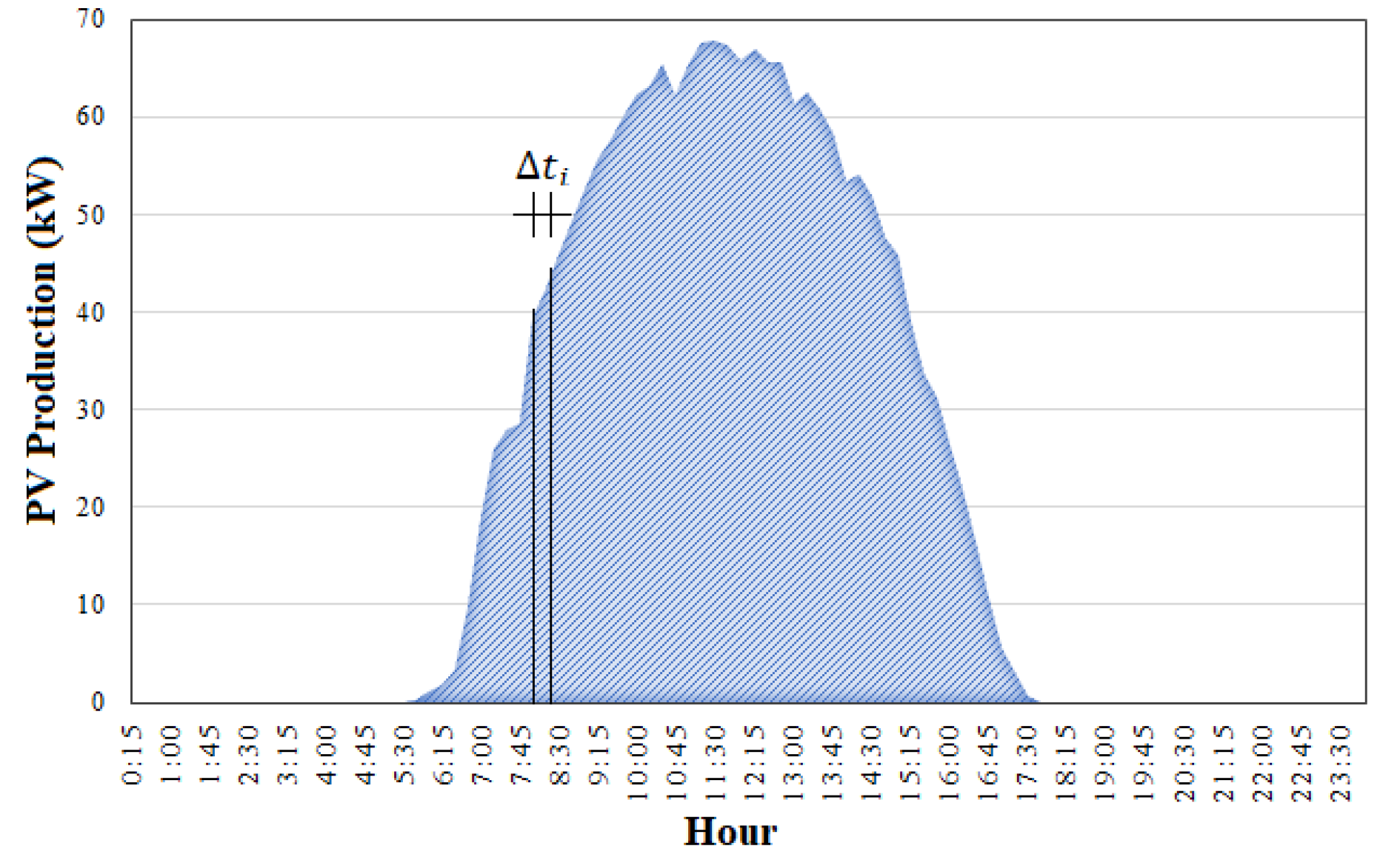
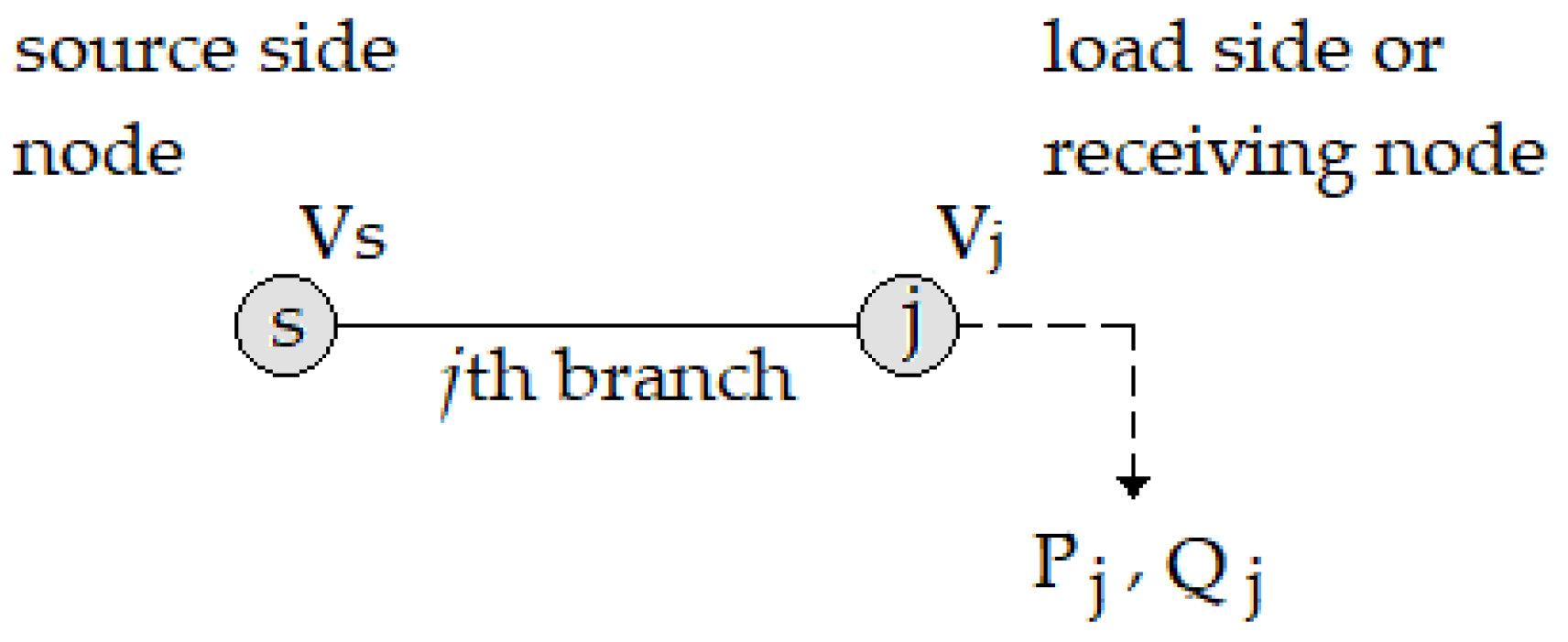
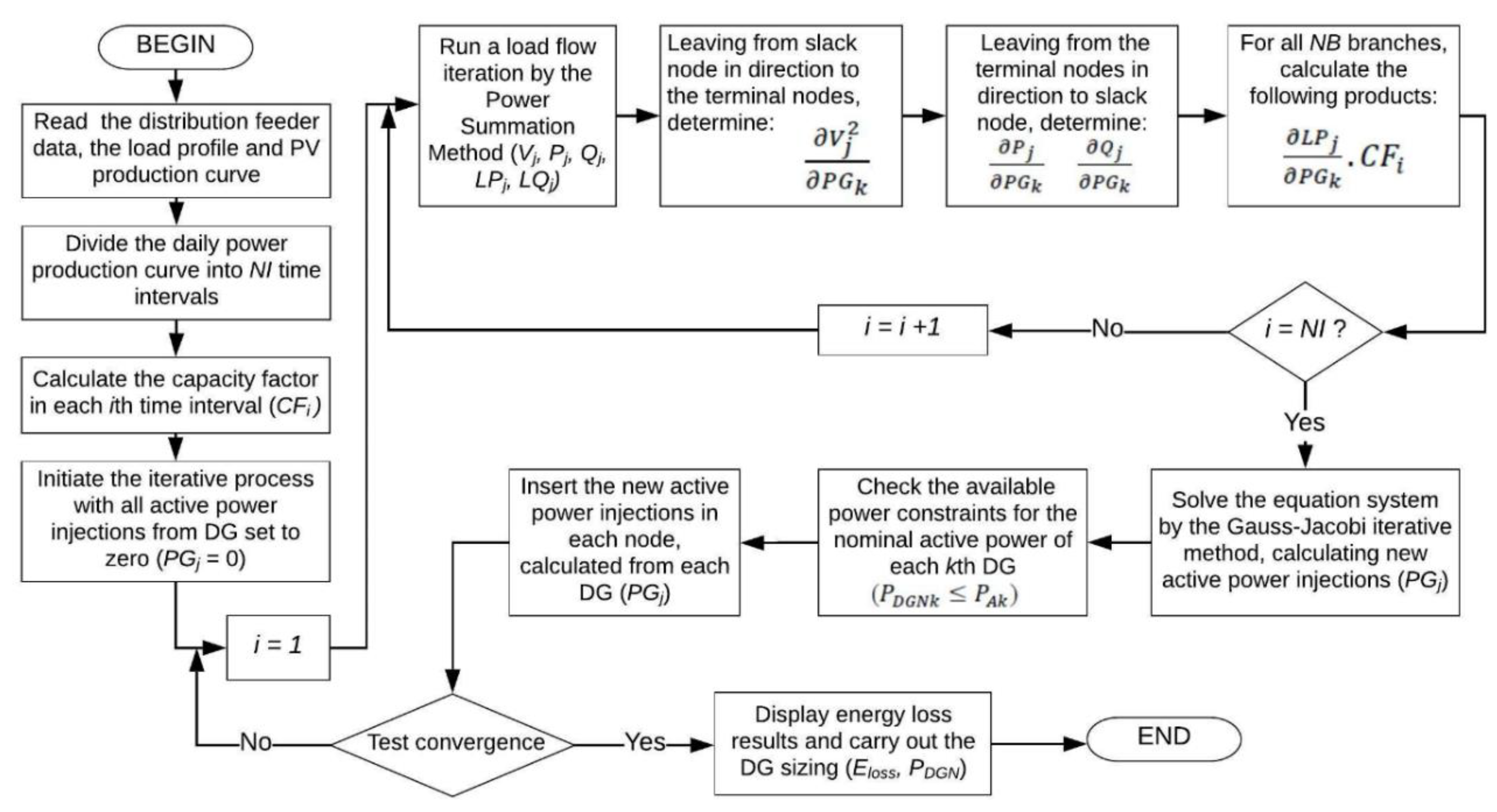
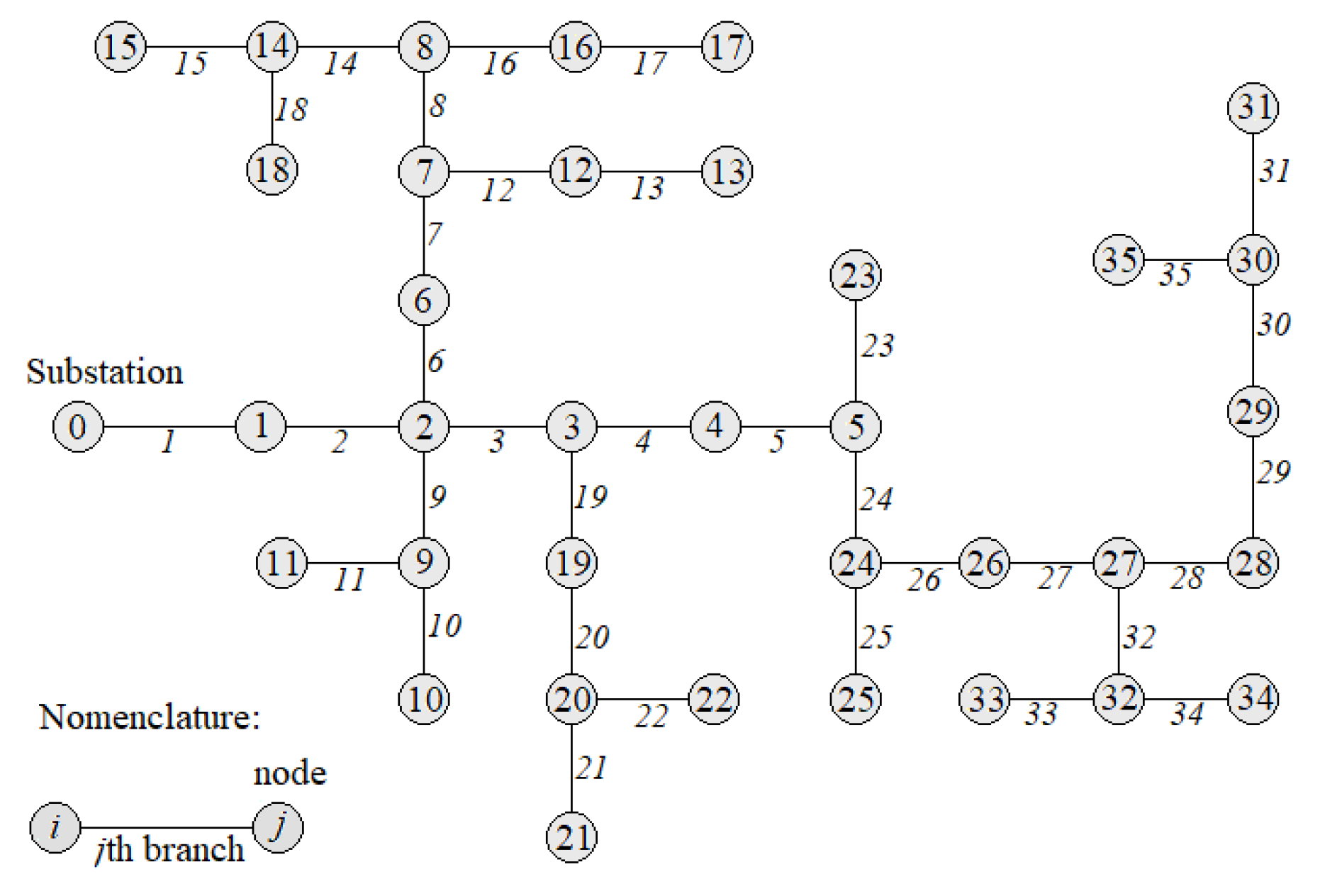
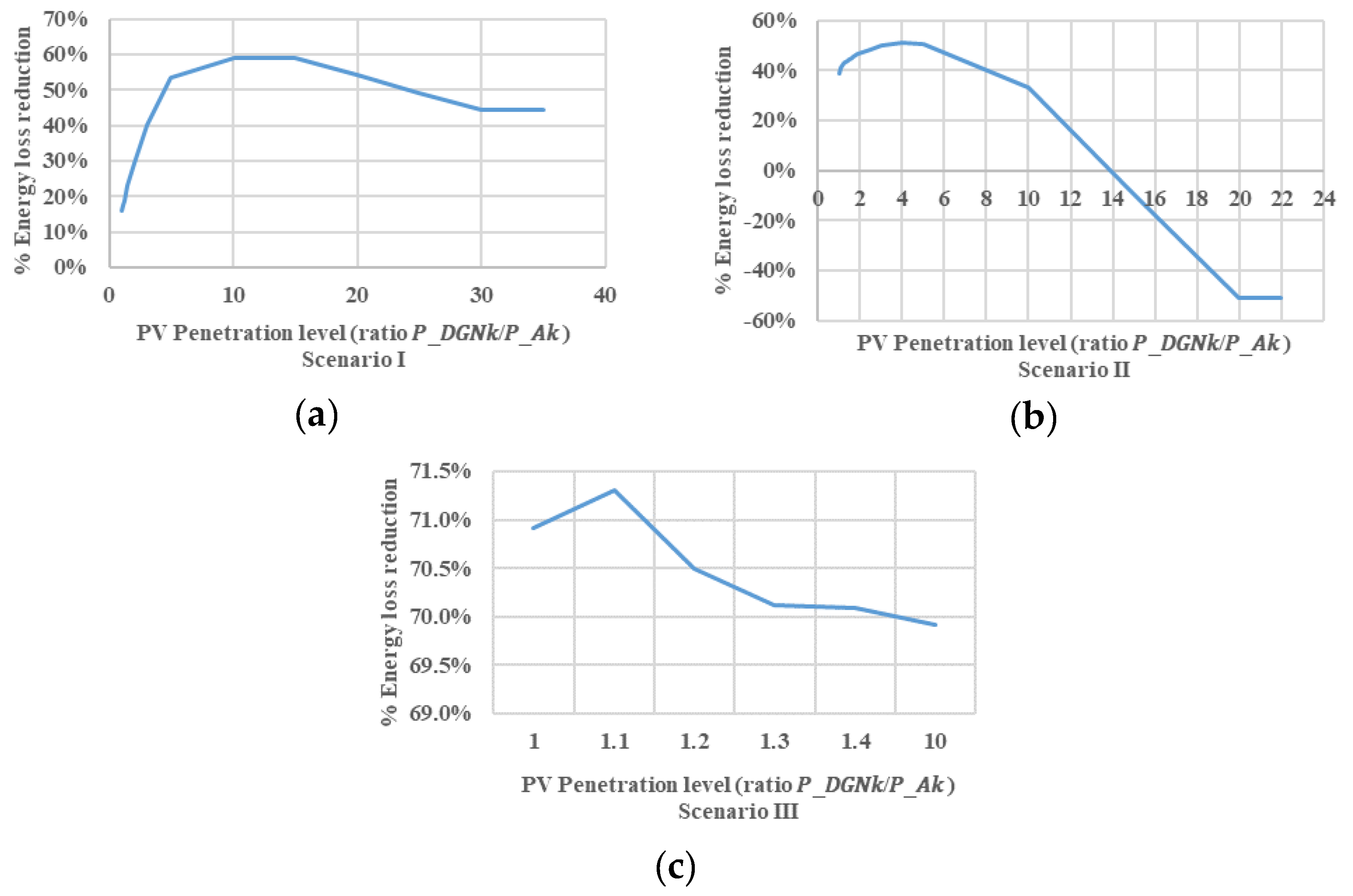
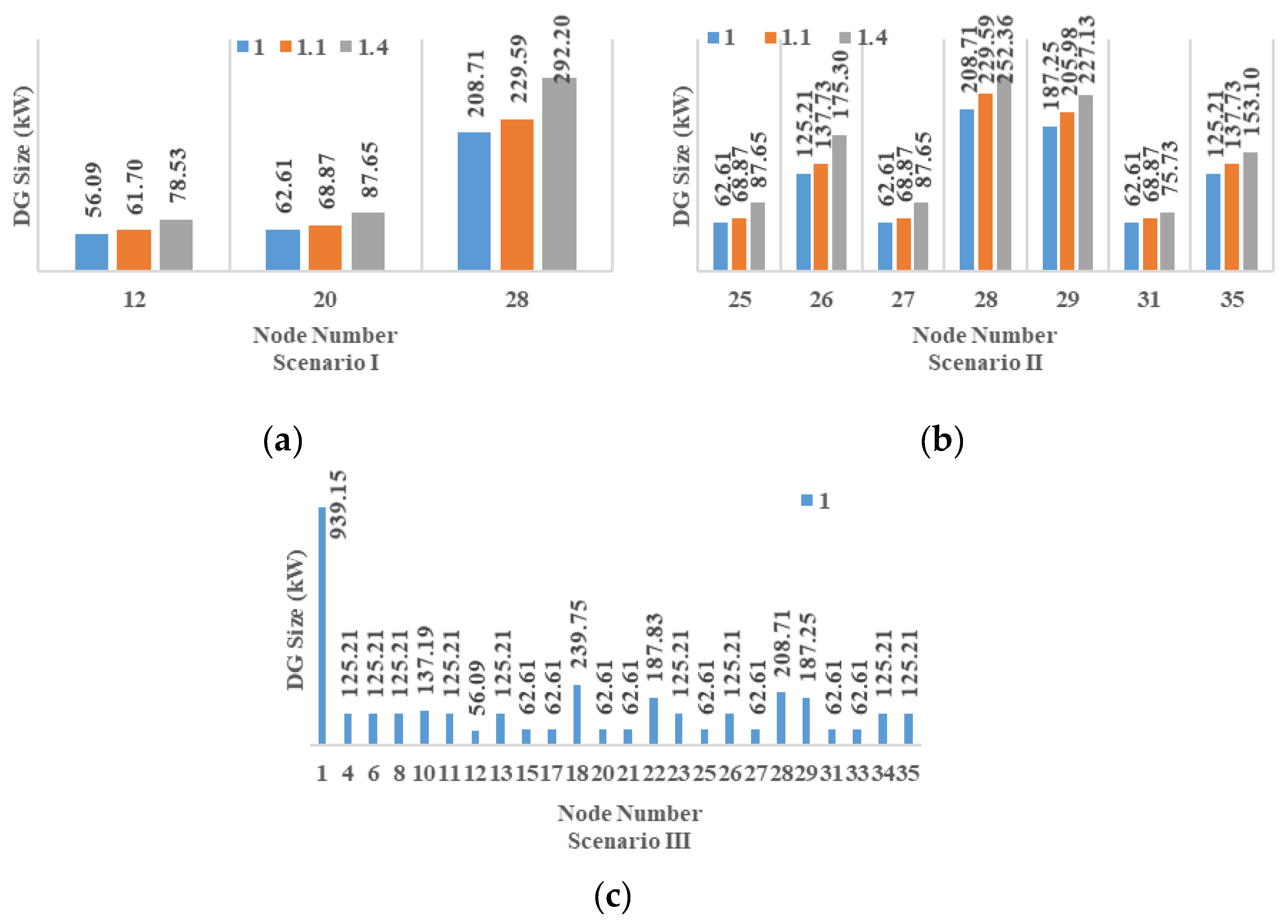
| Topology | Ratio Limit PDGNk/PAk | Total System Energy Losses (kWh) | Energy through the Slack Bus (MWh) | Total DG Size (kW) |
|---|---|---|---|---|
| Base case | 72.810 | 31.242 | 0.00 | |
| Scenario I (DG location in nodes 12, 20, 28) | 1.0 | 61.137 | 28.928 | 327.42 |
| 1.1 | 60.077 | 28.696 | 360.16 | |
| 1.2 | 59.037 | 28.465 | 392.90 | |
| 1.5 | 56.033 | 27.771 | 491.13 | |
| 2.0 | 51.418 | 26.615 | 654.84 | |
| 3.0 | 43.655 | 24.305 | 982.25 | |
| 5.0 | 33.973 | 19.690 | 1637.09 | |
| 10 | 29.917 | 13.080 | 2576.00 | |
| 15 | 29.879 | 8.906 | 3169.48 | |
| 20 | 33.207 | 4.735 | 3763.00 | |
| 25 | 37.135 | 1.857 | 4170.06 | |
| 30 | 40.495 | 0.000 | 4437.61 | |
| 35 | 40.495 | 0.000 | 4437.61 | |
| without constraint | 40.495 | 0.000 | 4437.61 | |
| Scenario II (DG location in nodes 25, 26, 27, 28, 29, 31, 35) | 1 | 44.765 | 25.347 | 834.22 |
| 1.1 | 43.101 | 24.759 | 917.64 | |
| 1.2 | 41.642 | 24.170 | 1001.06 | |
| 1.3 | 41.155 | 23.955 | 1033.88 | |
| 1.4 | 40.769 | 23.778 | 1058.92 | |
| 1.5 | 40.397 | 23.602 | 1083.97 | |
| 1.6 | 40.039 | 23.425 | 1109.02 | |
| 1.7 | 39.694 | 23.249 | 1134.06 | |
| 1.9 | 39.045 | 22.896 | 1184.16 | |
| 2.1 | 38.450 | 22.543 | 1234.25 | |
| 2.5 | 37.423 | 21.838 | 1334.44 | |
| 3.0 | 36.441 | 20.956 | 1459.67 | |
| 4.0 | 35.488 | 19.194 | 1710.13 | |
| 5.0 | 35.834 | 17.499 | 1952.17 | |
| 10 | 48.602 | 10.907 | 2891.44 | |
| 15 | 79.653 | 4.333 | 3830.70 | |
| 20 | 109.929 | 0.110 | 4446.09 | |
| 22 | 110.028 | 0.000 | 4447.50 | |
| without constraint | 110.028 | 0.000 | 4447.50 | |
| Scenario III (DG location in nodes 1, 4, 6, 8, 10, 11, 12, 13, 15, 17, 18, 20, 21, 22, 23, 25, 26, 27, 28, 29, 31, 33, 34, 35) | 1 | 21.176 | 5.986 | 3583.76 |
| 1.1 | 20.890 | 3.465 | 3942.14 | |
| 1.2 | 21.485 | 0.945 | 4300.51 | |
| 1.3 | 21.760 | 0.297 | 4391.12 | |
| 1.4 | 21.780 | 0.246 | 4397.96 | |
| 10 | 21.905 | 0.050 | 4439.80 | |
| without constraint | 21.905 | 0.050 | 4439.80 |
| Time Intervals (i) | 1 | 2 | 3 | 4 | 5 | 6 | 7 | 8 | 9 | 10 |
|---|---|---|---|---|---|---|---|---|---|---|
| Capacity Factor (CFi) | 0.200 | 0.660 | 0.836 | 0.940 | 0.986 | 0.965 | 0.887 | 0.757 | 0.538 | 0.264 |
| Load Factor (LFi) | 0.894 | 0.894 | 0.984 | 0.990 | 0.971 | 0.932 | 0.948 | 0.979 | 0.983 | 0.940 |
| Topology | Voltage before and after DG Location (pu) | |
|---|---|---|
| Min | Max | |
| Base Case | 0.9935 | 1.0000 |
| Scenario I | 0.9939 | 1.0000 |
| Scenario II | 0.9945 | 1.0000 |
| Scenario III | 0.9949 | 1.0000 |
| Topology | PV Production Level | Total System Energy Losses (kWh) | Energy through the Slack Bus (MWh) | Total DG Size (kW) |
|---|---|---|---|---|
| Base Case | 72.810 | 31.242 | 0.00 | |
| Scenario I Without constraint (ratio limit) | Typical | 40.495 | 0.000 | 4437.61 |
| Minimum | 40.495 | 0.000 | 5547.02 | |
| Maximum | 40.495 | 0.000 | 3698.01 | |
| Scenario II Without constraint (ratio limit) | Typical | 110.028 | 0.000 | 4447.50 |
| Minimum | 110.028 | 0.000 | 5559.38 | |
| Maximum | 110.028 | 0.000 | 3706.25 | |
| Scenario III Without constraint (ratio limit) | Typical | 21.905 | 0.050 | 4439.80 |
| Minimum | 21.882 | 0.024 | 5541.04 | |
| Maximum | 21.888 | 0.001 | 3692.93 |
© 2019 by the authors. Licensee MDPI, Basel, Switzerland. This article is an open access article distributed under the terms and conditions of the Creative Commons Attribution (CC BY) license (http://creativecommons.org/licenses/by/4.0/).
Share and Cite
Costa, J.A.d.; Castelo Branco, D.A.; Pimentel Filho, M.C.; Medeiros Júnior, M.F.d.; Silva, N.F.d. Optimal Sizing of Photovoltaic Generation in Radial Distribution Systems Using Lagrange Multipliers. Energies 2019, 12, 1728. https://doi.org/10.3390/en12091728
Costa JAd, Castelo Branco DA, Pimentel Filho MC, Medeiros Júnior MFd, Silva NFd. Optimal Sizing of Photovoltaic Generation in Radial Distribution Systems Using Lagrange Multipliers. Energies. 2019; 12(9):1728. https://doi.org/10.3390/en12091728
Chicago/Turabian StyleCosta, José Adriano da, David Alves Castelo Branco, Max Chianca Pimentel Filho, Manoel Firmino de Medeiros Júnior, and Neilton Fidelis da Silva. 2019. "Optimal Sizing of Photovoltaic Generation in Radial Distribution Systems Using Lagrange Multipliers" Energies 12, no. 9: 1728. https://doi.org/10.3390/en12091728





